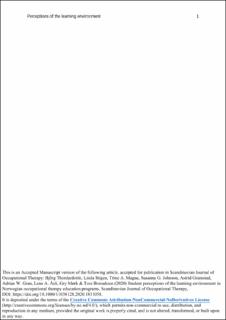| dc.contributor.author | Thordardottir, Björg | |
| dc.contributor.author | Stigen, Linda | |
| dc.contributor.author | Magne, Trine A | |
| dc.contributor.author | Johnson, Susanne Grødem | |
| dc.contributor.author | Gramstad, Astrid | |
| dc.contributor.author | Gran, Adrian Wetlesen | |
| dc.contributor.author | Åsli, Lene Angel | |
| dc.contributor.author | Mørk, Gry | |
| dc.contributor.author | Bonsaksen, Tore | |
| dc.date.accessioned | 2022-01-17T13:38:02Z | |
| dc.date.available | 2022-01-17T13:38:02Z | |
| dc.date.created | 2020-10-13T21:06:37Z | |
| dc.date.issued | 2020-10-12 | |
| dc.identifier.issn | 1103-8128 | |
| dc.identifier.issn | 1651-2014 | |
| dc.identifier.uri | https://hdl.handle.net/11250/2837685 | |
| dc.description.abstract | Background: To support students’ motivation towards constructive and persistent study efforts, their learning environment needs attention. Aim: To develop knowledge about occupational therapy students’ perceptions of the learning environment and assess whether identified differences between education programs were stable or changed across the three years of study. Methods: Norwegian occupational therapy students completed the Course Experience Questionnaire (CEQ) while in their first, second and third years of study. Differences between programs were analyzed with multivariate and univariate analysis of variance. Results: Among the first-year students, perceptions of the learning environment differed significantly between the six programs on five out of six scales. Apart from a continued difference on overall study satisfaction, the initial differences were no longer significant one year later. Differences on three scales (emphasis on independence, appropriate workload and generic skills) were present in the third year of study. Conclusions and significance: Students’ perceptions of the learning environment became more similar over time, during the first two years of study, possibly reflecting that the students have become more accustomed to the student role and to the culture and requirements of the education programs. However, differences between study sites re-occurring in the third year suggest that group-based comparisons of learning environment perceptions across time may be inconclusive. | en_US |
| dc.language.iso | eng | en_US |
| dc.publisher | Routledge | en_US |
| dc.relation.ispartofseries | Scandinavian Journal of Occupational Therapy; | |
| dc.rights | Attribution-NonCommercial-NoDerivatives 4.0 Internasjonal | * |
| dc.rights.uri | http://creativecommons.org/licenses/by-nc-nd/4.0/deed.no | * |
| dc.subject | Higher education | en_US |
| dc.subject | Learning environments | en_US |
| dc.subject | Students | en_US |
| dc.title | Student perceptions of the learning environment in Norwegian occupational therapy education programs | en_US |
| dc.type | Journal article | en_US |
| dc.type | Peer reviewed | en_US |
| dc.description.version | acceptedVersion | en_US |
| cristin.ispublished | true | |
| cristin.fulltext | preprint | |
| cristin.qualitycode | 1 | |
| dc.identifier.doi | https://doi.org/10.1080/11038128.2020.1831058 | |
| dc.identifier.cristin | 1839341 | |
| dc.source.journal | Scandinavian Journal of Occupational Therapy | en_US |
| dc.source.pagenumber | 1-23 | en_US |

